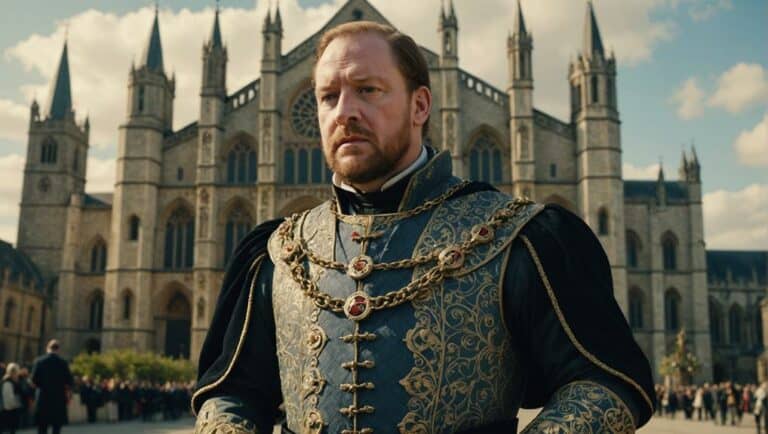King Henry VIII's desperate quest for a male heir led him to break from the Roman Catholic Church, reshaping religion in England.
Discover how pivotal figures like Thomas Cranmer and Thomas Cromwell catalyzed this transformation, leaving a legacy that profoundly influenced Elizabeth I's reign and beyond.
The Quest for a Male Heir
Henry VIII's unwavering pursuit of a male heir was mainly driven by his determination to safeguard the Tudor Dynasty's stability and continuity. The lack of a male heir with his first wife, Catherine of Aragon, was a crucial issue. Despite multiple pregnancies, Catherine only bore one surviving child, a daughter named Mary. This situation led Henry to question the legitimacy and future stability of his lineage, as the era's norms favored male succession.
Henry VIII's pursuit for legitimacy extended to his illegitimate son, Henry Fitzroy. Although Fitzroy couldn't legally inherit the throne, Henry's attempts to seek legitimacy for him underscored his desperation for a male successor. This desperation played a vital role in Henry's decision to seek an annulment from Catherine. The annulment wasn't just about personal discontent but stemmed from a broader strategic objective: securing a legitimate male heir.
Henry's pursuit of a male heir significantly influenced his decisions regarding marriages and heirs. This relentless quest culminated in what became known as the King's Great Matter, profoundly impacting his subsequent marriages and the drastic actions he took to assure a stable succession. His determination to secure a male heir ultimately resulted in monumental changes in England's religious landscape.
Papal Politics and Challenges
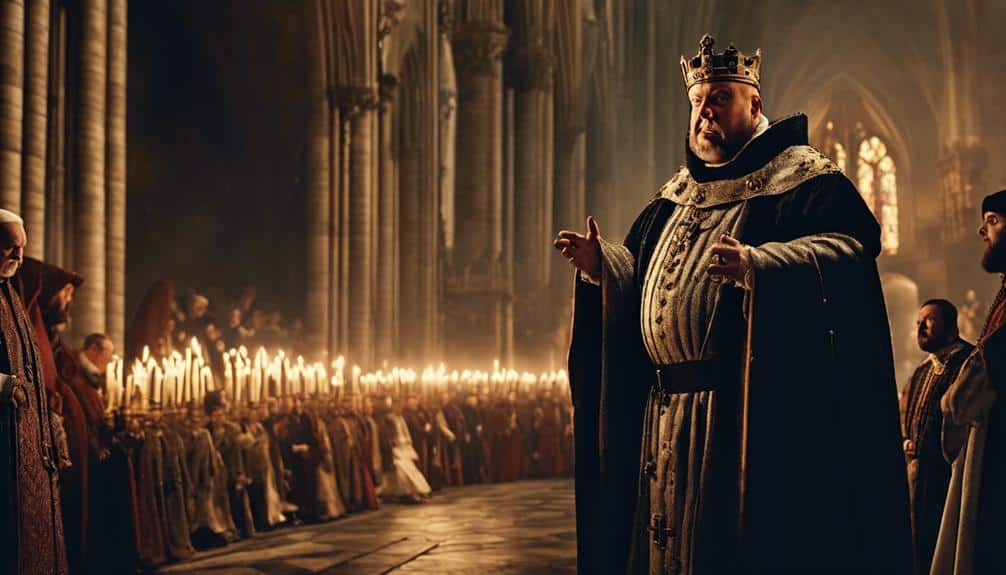
Obtaining a papal dispensation for the annulment of Henry VIII's marriage to Catherine of Aragon proved exceptionally challenging due to the complex political entanglements and the Pope's precarious position. Pope Clement VII faced immense pressure because Catherine was the aunt of the Holy Roman Emperor, Charles V, who had significant influence over the Pope.
The 1527 attack on Rome by Charles V's forces further complicated matters, making the Pope reluctant to grant Henry's request. Cardinal Thomas Wolsey, tasked with negotiating the annulment, found himself entangled in these geopolitical dynamics. Despite his efforts, the prolonged negotiations bore little fruit, frustrating Henry.
The Pope's authority was under siege, and he couldn't afford to alienate Charles V, risking the stability of his own position.
Key challenges included:
- Papal Authority: The Pope's need to maintain authority while balancing political alliances.
- Holy Roman Emperor: Charles V's influence over the Pope due to familial ties with Catherine.
- Cardinal Thomas Wolsey: His unsuccessful attempts at negotiating the annulment.
- Negotiations: The drawn-out and complex nature of diplomatic efforts.
- Protestant Solution: Henry's shift to advisors like Thomas Cranmer and Thomas Cromwell for alternatives.
Ultimately, Henry's impatience led him to seek a Protestant solution, setting the stage for significant religious transformation in England.
Establishing the Church of England
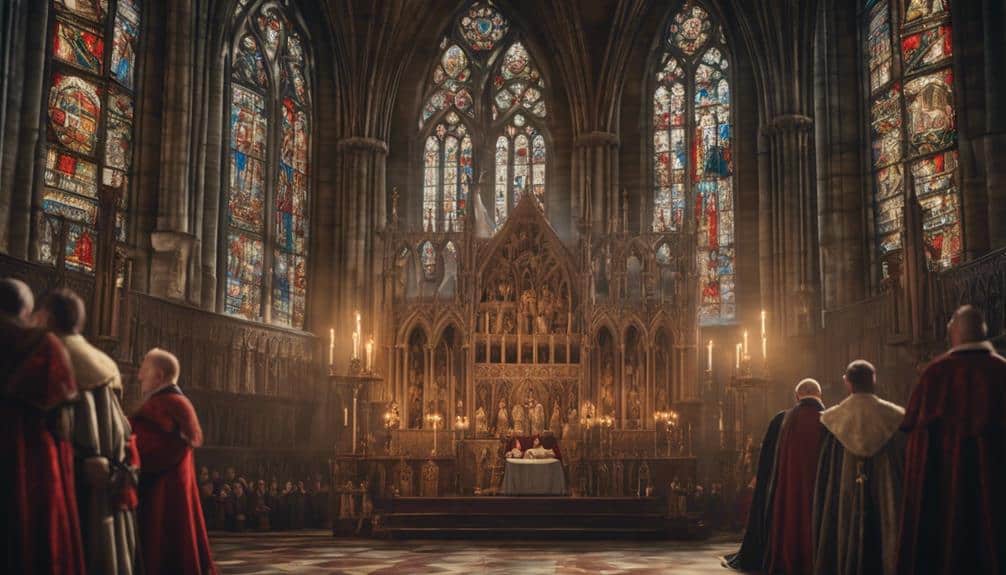
Through the Act of Supremacy in 1534, the English Crown decisively severed ties with the Roman Catholic Church, establishing the monarch as the Supreme Head of the Church of England. This pivotal act empowered Henry VIII to reconfigure the religious landscape of England, initiating the English Reformation. By declaring himself the Supreme Head, Henry effectively transferred ecclesiastical authority from the Pope to the English Crown.
The Archbishop of Canterbury, Thomas Cranmer, played an essential role in this transformation. As Henry's chief religious advisor, Cranmer facilitated the annulment of Henry's marriage to Catherine of Aragon and spearheaded the restructuring of the Church of England. The Reformation Parliament passed a series of laws that dismantled papal influence and reinforced the Crown's control over religious matters.
The Dissolution of the Monasteries, conducted from 1536 to 1540, further entrenched the Church of England's dominance. By dissolving these Catholic institutions, Henry not only eliminated potential opposition but also seized their considerable wealth, enhancing the treasury.
Key Figures and Their Roles
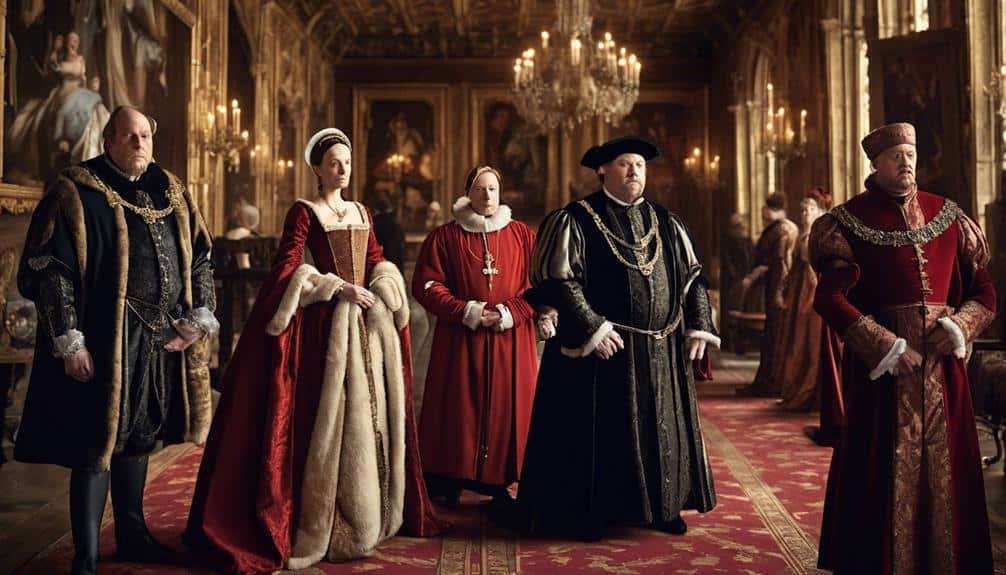
Key figures like Cardinal Wolsey, Thomas More, and Thomas Cromwell played pivotal roles in influencing the course of Henry VIII's religious and political maneuvers during 'The Great Matter.' Each of these key figures had distinct contributions that shaped the trajectory of Henry's quest for an annulment from Katherine of Aragon, leading to the eventual break with Rome.
- Cardinal Wolsey: Initially tasked with securing the annulment, Wolsey's failure to obtain the Pope's consent led to his downfall. His inability to deliver on Henry's demands resulted in his dismissal and eventual death.
- Thomas More: As a close advisor, More initially supported the king's policy but later opposed the divorce and break with Rome, leading to his resignation and execution.
- Thomas Cromwell: Cromwell's political acumen enabled him to devise the plan for the break with Rome. He served as Vicar General, implementing the reformation and ensuring the divorce from Katherine.
- Henry VIII: His determination to annul his marriage to Katherine of Aragon was the driving force behind these events, relying heavily on these advisors.
- Katherine of Aragon: Her steadfast refusal to accept the annulment significantly influenced the protracted and contentious process.
The Legacy of the English Reformation
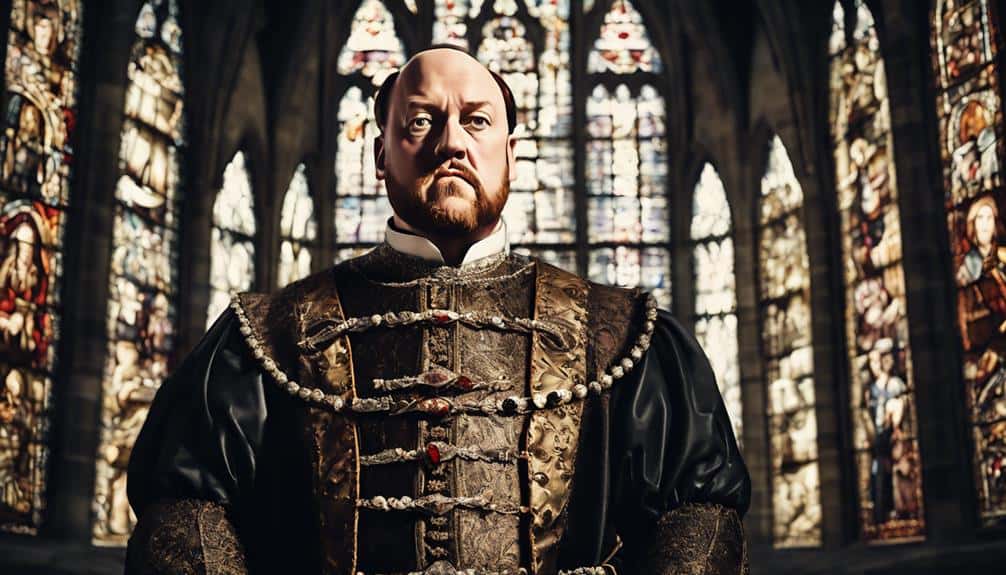
The English Reformation's legacy fundamentally altered the nation's religious structure, shifting authority from the Pope to the English Crown and reshaping England's spiritual and political landscape. King Henry VIII's decision to seek a divorce from Catherine of Aragon was the catalyst for this monumental change. When Pope Clement VII refused to annul the marriage, Henry VIII took drastic measures, severing ties with the Catholic Church and establishing the Church of England with himself as the Supreme Head.
Through the Reformation Parliament from 1529 to 1536, laws were enacted that transferred religious authority from the Pope to the Crown, profoundly impacting national life. These legislative changes not only redefined religious doctrine and practices but also cemented the monarch's control over religious matters. This shift diminished the Pope's influence in England and bolstered the power of the English monarchy.
Queen Elizabeth I's reign marked the completion of the Reformation initiated by her father, Henry VIII. Her policies reinforced the break from the Catholic Church and solidified Protestantism's role in English society. The legacy of the English Reformation is evident in the enduring structure of the Church of England and the ongoing separation of church and state authority.


